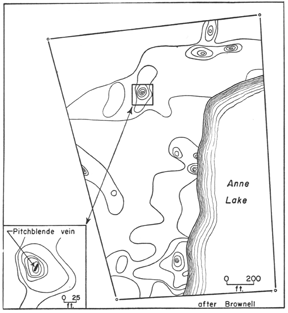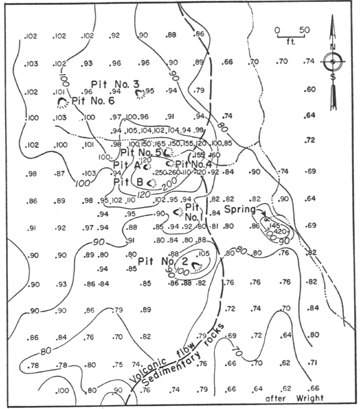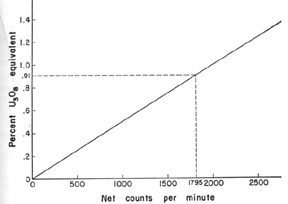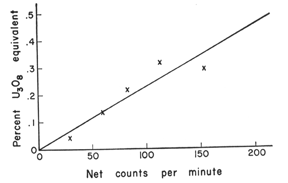General Reconnaissance. General reconnaissance with the counter is the simplest method of counter prospecting and consists of nothing more than walking over the area selected for prospecting with the counter turned on and held at a constant distance from the ground. The counter may be kept in its carrying case or held in the hand. If it has an external probe, it may be strapped to a walking stick, to the leg, or merely slipped into the top of one's boot to bring it closer to the ground. While walking, the prospector must either wear the earphones and listen for increases in the counting rate or keep his eye on the blinker or ratemeter.
After having arrived in the area of interest, but before starting the reconnaissance, the background count must be checked, and this should be repeated every hour or so. In reconnaissance of this type the counter will register only the background count most of the time and the prospector will quickly recognize any substantial change due to encountering radioactive material. It is important, however, not to confuse such changes in counting rate with changes due to different rock types, topography, or fluctuation in cosmic activity.
If at any place the counter registers an appreciable increase in counting rate, the prospector should stop and measure the rate, comparing it to the background count. If the rate is two or three times the background, a close examination should be made by moving the counter (or the probe) slowly over the rock or ground surface in order to determine exactly the source of the radioactivity. At this point, the importance of knowing the uranium and thorium minerals and something of their occurrence becomes evident, because the prospector must try to identify what is causing the radioactivity. For example, he should try to determine whether the radioactivity is coming from a small vein or pocket of high-grade uranium or thorium minerals that might be an important find, or from a larger area containing sparsely distributed minerals of low radioactive content which, because of the mass effect, has caused the higher reading, but which may be of no importance as a source of uranium or thorium. A large area of weakly radioactive rocks may cause the same effect on the counter as a small specimen or vein of high-grade ore.
If an area is encountered that consistently gives readings of several times background, it should be carefully prospected. The high readings may either represent a large, relatively low-grade deposit, or indicate the presence of a higher-grade deposit somewhere in the vicinity.1If the radioactivity at any particular place is four or more times background, a sample should be taken.
In reconnaissance with the counter, it is important not to walk too rapidly, for then the counter may not have time to register narrow streaks or small spots of radioactive minerals. The few additional clicks in the earphones or flashes of the light from a rapidly passed source of radioactivity are likely to be confused with a "burst" of cosmic radiation or other normal fluctuations, and a ratemeter may show no reaction at all.2 In areas where preliminary reconnaissance indicates repeated readings appreciably higher than background, it is good practice to stop frequently and take readings of one minute or more3 with the counter or probe on the ground.
1In some cases, only a slight increase in background count, if it is consistent over an area and cannot be related to a change in rock type, may indicate favorability for further prospecting.
2 This is because of factors called statistical error and time-constant.
Statistical error: All counter readings fluctuate due to the fact that gamma rays trigger the counter at irregular intervals of time. This is particularly a factor with a counter having headphones or a neon light to detect individual pulses which occur in bunches or clusters. It is for this reason that counts taken over longer periods of time are more accurate..
Time-constant: All counters having meters use integrating circuits to receive and smooth out the irregularly spaced, individual impulses from the amplifier and to provide an average reading. If the circuit is adjusted to average counts over a relatively long period of time, the instrument is said to have a long time-constant. With a long time-constant, fluctuations of the meter needle are slight, and the meter reading is stable, but the meter has a sluggish response to changes in radiation. With a short time-constant, the needle fluctuates widely, and an average reading may be hard to obtain. If the time-constant of a particular instrument proves unsatisfactory, it can be modified by a radio serviceman. Some of the more expensive counters have several time-constants which can be selected by a switch.
3 When counting individual pulses, the larger the number of pulses measured, the greater the accuracy. Thus, accuracy is improved by increasing the length of the counting period or by using an instrument of higher sensitivity that will react to a larger proportion of the radiation; accuracy is automatically improved as the degree of radioactivity being measured increases. The need for accuracy depends upon the purpose of the reading. For a quick check on an outcrop, counting for a few seconds with the average counter is adequate. Background readings should be taken over a period of at least a minute. Readings for detailed outcrop testing, sample analysis, or radiometric surveying should be not less than 3 minutes.
Outcrop Testing. If a radioactive vein or bed is discovered during the general reconnaissance, a good preliminary estimate of its importance can often be made by systematic counter measurements along its outcrop. Three-minute readings should be taken at regular intervals, about every 5 feet, along the vein or exposed edge of the bed with the probe or tube lying across the outcrop perpendicular to the long dimension and placed in the center of the outcrop if it is wider than the length of the probe.1 These readings, less the background count, and their location should be recorded.
At the location of about every tenth reading, a sample should be taken for chemical assay. When the results of these assays are available, they can be used to calculate the uranium or thorium content at the locations where samples were not taken, permitting a reasonably good preliminary estimate of the grade of the entire length of the outcrop with a minimum of sampling and assaying. Care must be taken at each reading that the probe is always in the same position relative to the outcrop to minimize the error from mass effect, absorption, and other factors. Many more experienced prospectors, after having become thoroughly familiar with their counters and various methods of field prospecting, can make rough estimates of the grade of an outcrop without collecting samples or prior to receiving the assays. This, of course, involves the assumption that the material being measured is in equilibrium or in approximately the same degree of equilibrium as material previously tested. If this is not true, serious errors can be made. This method should never be used for a final appraisal of a deposit.
Radiometric Surveys. If a general reconnaissance indicates an area of unusually radioactive rocks, it may be desirable to make a systematic radiometric survey, sometimes called a grid survey, to determine the pattern of the radioactivity and to see whether it may reveal information that could be of value in finding and developing a commercial ore body. Such information on the distribution of the radioactivity can be very useful in planning outcrop sampling, test pitting, diamond drilling, or underground workings. In this type of survey the area under investigation is marked off with a compass and tape or by pacing in a grid pattern with squares 10, 20, or more feet on a side, depending upon the size of the area and the observed degree of variation
With a ratemeter this problem is automatically handled by the time-constant of the integrating circuit, and it is necessary only to wait a few seconds until the needle becomes reasonably steady before taking the reading. The longer the time-constant, the longer this will take. Although the long time-constant gives greater accuracy, the resultant sluggishness of the needle is often undesirable for reconnaissance work. The proper time-constant will vary with the use to which a counter is put.
1 If a scintillation counter is used with the crystal at the end of the probe, it should be held vertically and in the center of the outcrop.
in radioactivity from place to place.l Readings are taken with the probe on the ground over a counting period of at least one minute at stations located at the corners of the squares. If a ratemeter is used, the needle fluctuations can be averaged by eye; otherwise the number of individual counts is recorded.
After a count has been made at each station, the stations and corresponding readings are plotted on a map. The readings can be recorded on the map in one of the following ways:
1. The actual counter reading in counts per minute or mR/hour.2
2. The net counter reading in counts per minute or mR/hour after subtracting the background count.
3. The ratio of counter reading to background. That is, the reading is expressed in terms of the number of times it is greater than the background count. A reading of 125 counts per minute in an area where the background is 50 would be expressed as 125/50 or 2.5.
The second and third methods are preferable because they eliminate the background count. The background is obtained by taking the average of several readings immediately outside the area being surveyed.
When readings have been plotted on the map, lines are drawn connecting the points of greatest radioactivity represented by the highest figures. Then lines are drawn connecting the points of next highest radioactivity and so on until a contour map showing lines of equal radioactivity or isorads has been prepared in the same manner that a topographic map shows lines of equal elevation. Such a map, showing the location, size, and shape of the areas of highest radioactivity may provide a clue to an ore zone or mineralized structure that is not apparent to the eye or by simple counter reconnaissance.
1 wide variation in radioactivity over short distances will require a closer spacing of readings to determine accurately the pattern of radioactivity and thus a smaller grid.
2 The unit of measurement used on most ratemeters is the same as that used to measure X-rays. This standard unit is the roentgen (R) which is a measure of the quantity or amount of radiation, regardless of whether that quantity is produced quickly by intense radiation or slowly by slight radiation. Therefore, the intensity of radiation is expressed as a rate or as roentgens per unit of time. Since radioactivity in nature is low compared to X-rays or other artificial sources of radiation, most counters are calibrated in milliroentgens, 1/1000 roentgen (mR), per hour.
Average background radioactivity on the earth's surface is in the range of 0.02 to 0.05 mR/hr which is measured on the most sensitive (01) scale of the three scales usually found on a ratemeter. These are usually referred to as the "01," "1," and "10" scales because they measure hundredths of milliroentgens, milliroentgens and lO's of milliroentgens, respectively. If a source of radiation is so strong that the needle starts to go off the scale, the sensitivity can be changed to the next highest (less sensitive) scale by turning a control knob. Some scintillation counters and a few Geiger counters have meters which read directly in counts per minute or counts per second. A very few counters have their meters calibrated in terms Of per cent uranium or U308 Since there are a large number of reasons why it is impossible to measure the uranium content directly, this type of scale is not valid and should be used in the same manner as those calibrated in milliroentgens.

PLATE XXVIA. Radiation survey of the Jim Claim, Saskatchewan. The radiation survey of this claim showed a previously
unknown radioactivity high in the northern portion of the area. Exploration here resulted in the discovery of a pitchblende vein.
From Prospecting With a Counter, R. J. Wright. Courtesy U. S. Atomic Energy Commission.

PLATE XXVIB. Radiation survey of the Annie Laurie prospect, Arizona. This survey was used to locate the test pits. Note the
difference in background radioactivity between the sedimentary rocks and the volcanic flow. Radioactivity was first discovered
here when the spring deposits were tested with a counter. From Prospecting With a Counter, R. J. Wright.
Courtesy U. S. Atomic Energy Commission.
To make certain that as much useful information as possible is available on the map, the counter should be left on while moving from one station to the other and additional readings taken and plotted between the stations at any point where a marked change in radioactivity is noted. The scintillation counter is particularly well adapted to radiation surveys because of its high counting rate (sensitivity) and long time-constant, permitting very reliable readings, and the added advantage with some instruments of being able to check the sensitivity to make certain it does not change during the survey and to adjust it if changes do occur.
Radiometric Assaying. The only completely reliable way to determine the exact uranium or thorium content of a sample is to obtain a chemical analysis which determines either or both of them directly and is not affected by the proportions of each or its daughter products present. Analyses are expressed in terms of uranium oxide, U3O8, or thorium oxide, Tho2 To indicate that an assay was made by chemical methods, the symbols "chem." or "c" are usually used after U3O8 or ThO2 For example, 15 percent U3O8c. If a sample is in equilibrium, a reasonably accurate analysis of either uranium or thorium can be made by measuring its radioactivity if there is not a significant amount of the other present. This fact must be determined in advance by other means-by a knowledge of the minerals in the sample or by chemical analysis of other samples from the same deposit. Such measurements can be made quite accurately, given the conditions described, with laboratory counters especially designed for the purpose and now used in most government and large commercial laboratories. Their advantages are the speed with which the assays can be made and the low cost.
The sample is crushed, ground, and placed in a sample holder surrounded by a lead shield which very much reduces the background count. The instrument records the number of counts during a given counting period, or the length of time taken to record a given number of counts. The radiometric assay can then be determined from the recorded count or time interval by the use of a graph which has been prepared for that specific counter on the basis of measurements taken on chemically assayed "standard" samples. The assay is expressed as "U3O8 (or ThO2 equivalent." An assay of 0.26 per cent U308 equivalent means that the sample has the same degree of radioactivity as a sample which is in equilibrium and contains 0.26 per cent U308 by chemical analysis and that has no thorium present. The symbols U308 equiv., U308e, or U308 red. (or ThO2 equiv., ThO2e, or ThO2 red.) are usually used for radiometric assays.
Portable field counters can be used to make rough assays of samples by using the same general procedure for laboratory radiometric assaying described above.

PLATE XXVIIA. Calibration chart for a laboratory counter. By use of the graph the radioactivity of a rock sample can be recalculated as percent U3O8 equivalent; for example, a sample which yields 1795 net counts per minute assays 0.91 percent U3O8 equivalent. A calibration chart can be used only for the counter for which it was prepared. From Prospecting With a Counter, R. J. Wright. Courtesy U. S. Atomic Energy Commission.

PLATE XXVIIB. Calibration chart for a field counter. This graph was prepared by plotting the radioactivity of five assayed samples, indicated by x. A held counter is less sensitive than a laboratory counter and hence detects fewer counts for a given amount of uranium. From Prospecting With a Counter, R. J. Wright. Courtesy U. S. Atomic Energy Commission.
This method of assaying has been called the counter comparison test and involves the following steps:
1. Record the background count.
2. Place next to the center of the counter probe a standard sample having a uranium or thorium content of the same general range that it is believed the unknown sample may have, and record the count.
3. Remove the standard sample, take the background count again, and place the unknown sample in the same position relative to the probe as the known sample was placed, and record the count. The unknown sample should be the same size as the standard sample, and preferably both samples should crushed or ground and in containers of the same size.
4. Subtract the background count from the sample count in each case. The the uranium or thorium content of the unknown sample is to the content the known sample as the net count of the unknown sample is to that of the known. For example:

If known = 0.5% U308; unknown=1.0% U308
For this test, counts of at least three minutes' duration should be made, and direct count rather than a meter reading is preferable for greater accuracy. If the probe has a window to permit recording of beta radiation, it should be used.
Counter Care and Maintenance. All of the electronic components of the Geiger counter are standard items and can be repaired or adjusted by qualified radio serviceman. The Geiger tube, however, must usually be replaced if it ceases to function properly. Many radio shops in the western states now make a regular business of checking and repairing counters. If operating difficulties are encountered with the counter, the first thing that should be checked is the tube simply by replacing it with another to see if the difficulty is eliminated. The prospector should, if possible, always carry a spare tube.
Scintillation counters are somewhat more complicated than Geiger counter and may require extensive work by an expert if they break down. In the scintillation counter there are two parts that cannot be repaired and must be replaced when they fail-the crystal or phosphor and the photomultiplier tube.
Most portable field counters are built to stand considerable rough handling, including the usual number of knocks and bumps. However, they are basically delicate instruments, and the more protection they are given against abuse, the longer and better they will operate. The following rules will help:
1. Protect the counter from direct contact with water. Do not use it in the rain, and protect it with a waterproof case or covering when in wet mines.
2. Do not use it in excessively humid climates or regularly in wet mines unless it has been "tropicalized." Tropicalized counters can be purchased for an additional cost.
3. Do not allow it to become overheated.
4. Do not allow it to come in contact with ore samples, radioactive dust, or radon-saturated mine air.
5. Do not allow the counting mechanism to operate so rapidly that the individual clicks cannot be distinguished or the meter hand swings off the dial. To avoid this, adjust it to a less sensitive scale or move it farther away from the source of radioactivity.
When a counter ceases to operate for no apparent reason it is often because the batteries need replacement. Depending upon the complexity of the counter, it may operate on simple flashlight batteries or on several different types of batteries. The manufacturer's instructions provided with the counter show how the batteries should be replaced. Care should be taken to follow these instructions to the letter in order to avoid shock from the high-voltage power supply which may be as high as 1,000 volts in some counters.
Return to "The Uranium Ore Minerals" (Minerals For Atomic Energy)
Return to Uranium Ore
Return to Main




